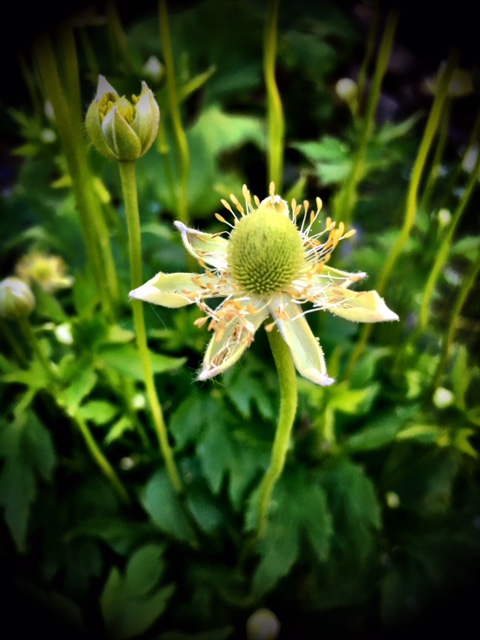
Thimbleweed: Native Plant Review. In this image, a single thimbleweed blossom stands tall on a stem that allows it to sway in the wind.
Going Partly Native
Two years ago, we started a new bed that was all native plants, including a button bush and a thimbleweed that we purchased at the annual native plant sale at Matthaei Botanical Gardens. You may be able to find similar plant sales near you. (To read about the all-native collection of plants in Serendipity Gardens, see Planting a Native Garden.)
Many references tell us that native plants are the best to plant for a number of reasons. Here are some of them:
According to the U.S. Fish and Wildlife Department, plants native to your area will attract more native pollinators. They note that “native plants can [also] serve as larval host plants for some species of pollinators.”
The Xerces Society, in its book Attracting Native Pollinators, reiterates this point. It quotes Gordon Frankie’s research, which “demonstrates that native plants are four times more likely than nonnative plants to attract bees.” The presence of native vegetation “significantly increases the abundance of butterflies and moths.”
Research by Douglas Tallemy and his colleagues at the University of Delaware came to similar conclusions, with native plants supporting three times as many butterfly and moth species as introduced plants. Native woody plants, the researchers found, supported 14 times as many species as introduced ornamental species! To read a Q&A with Dr. Tallemy conducted by Margaret Roach, visit the A Way to Garden website.
Finally, native plants offer many benefits to the gardener as well. They generally need little or no fertilizer. They protect themselves from harmful insects, meaning no poisons to store, watch over, and spread. They require less watering, and are less likely to become invasive. Finally, they promote local biological diversity, making your garden a more interesting and entertaining place as well as doing good for the environment.
Perhaps the better question would be, “Why on earth would you NOT use at least some native plants?” Our philosophy at Serendipity Gardens is that the garden can have many native plants in it plus a few of the gardener’s favorite ornamental plants. Something for everyone — that’s the middle road that seems right to me on this somewhat contentious issue.
Building Habitat
For us at Serendipity Gardens, it’s all about providing habitat. We want to do our small part to replace what has been lost. Toward that end, we are gradually replacing some non-native plants with native ones. When we purchase a plant today, to replace one that has died or to add to a bed, we consider the usual things: growth habit, color, fragrance, growing conditions — but we also consider function. How does it work in the ecosystem? Does it carry its weight or make any contribution at all?
This is a major change in our thinking about plants.
This post focuses on the humble thimbleweed, sometimes called a candle thimbleweed or long-headed thimbleweed. Its official name is anemone cylindrica A. Gray. In our garden, this plant is now in its third, or “leap” year. (According to an old garden saying on perennials, “the first year, they sleep; the second year, they creep; the third year, they leap.”)
It’s Blooming!
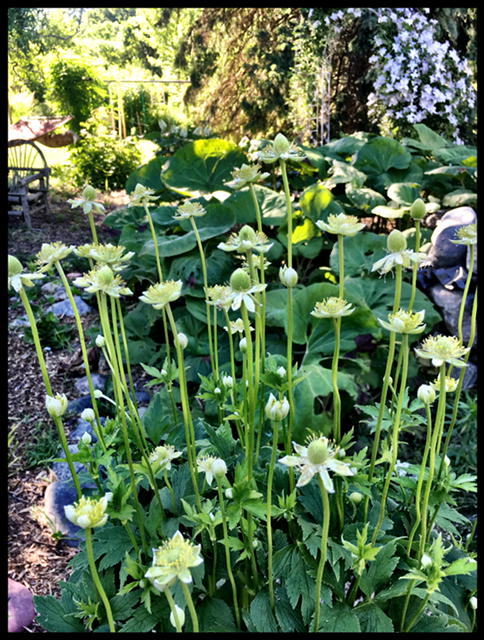
Thimbleweed: Native Plant Review
This thimbleweed began blooming in mid-June — and for a week or two before that, it began putting up its long stems crowned by leaves. The blooms — daisy shaped greenish white blossoms — are nice but not spectacular . The seed head resembles a green thimble and is surrounded by bright yellow stamens. The plant in our garden is about five feet tall, as shown in this photo.
Its primary interest from an appearance point of view is not the blooms, however. Rather, it is the plant’s architecture. Shaped somewhat like a three-tiered wedding cake, candle thimbleweed has a set of three-lobed basal leaves (see photo below). From this, multiple stems arise with a whorl of leaves higher on the stem. From these, the buds come, and then the flowers, each held on a stalk about six to eight inches long.
When the blooming is done, according to Wikipedia, the plant makes fruits called achenes. When ripe, they have gray-white, densely woolly styles that allow them to blow away in the wind. Last year, we had one such “woolly style” that we cut back this spring. This year, we will have dozens of them.
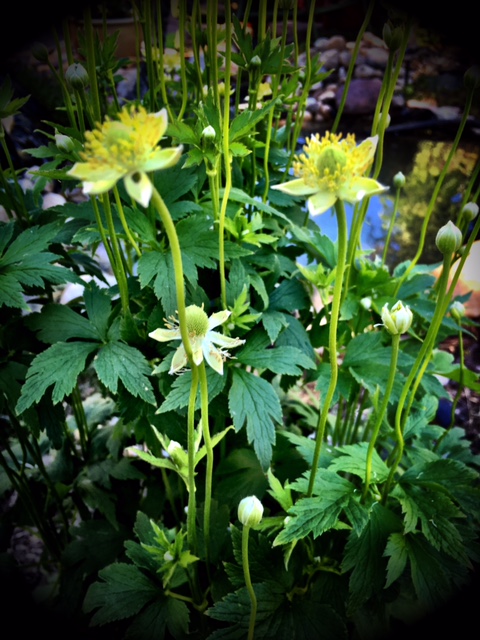
A group of thimbleweed flowers stands ready for the insects it attracts.
So, does thimbleweed add beauty to the garden? Yes, it does, though it is not the beauty of a bright rose or phlox. Rather, its beauty is much more subtle. In our particular garden, it stands near a hollyhock with yellow flowers, and the two shapes and colors mimic each other. Quite a nice bit of serendipity, particularly when viewed from a distance.
The whole thimbleweed picture has many benefits. The blossom, for instance, with its yellow stamens, is lovely. The felted leaves feel soft to the touch. The thimble itself is vivid light green and has an interesting texture. The cottony fruit is, well, cottony. The top of the plant swaying back and forth with the wind is nice to look at. Later in the summer, the stems turn red!
The plant can be interesting to children, too. It provides a reason to explain to a child who has never seen one what a thimble is, for example. The leaves are fun to touch as well.
Thimbleweed Pros
- Adds subtle beauty
- According to the Native Plants Database at the Lady Bird Johnson Wildflower Center, attracts predatory or parasitical insects that prey upon pests
- Adds height and striking architecture
- Adds motion to the garden as the flowers sway in the wind
- Potentially interesting to children
- Provides easy care — basically, you plant it and watch it grow, and do some minor cutting back in the spring
Thimbleweed Cons
- Somewhat muted color
- Stems may need support after a heavy rain or wind
- Cottony appearance of open seed heads is interesting, but not particularly beautiful
More Thimbleweed Images
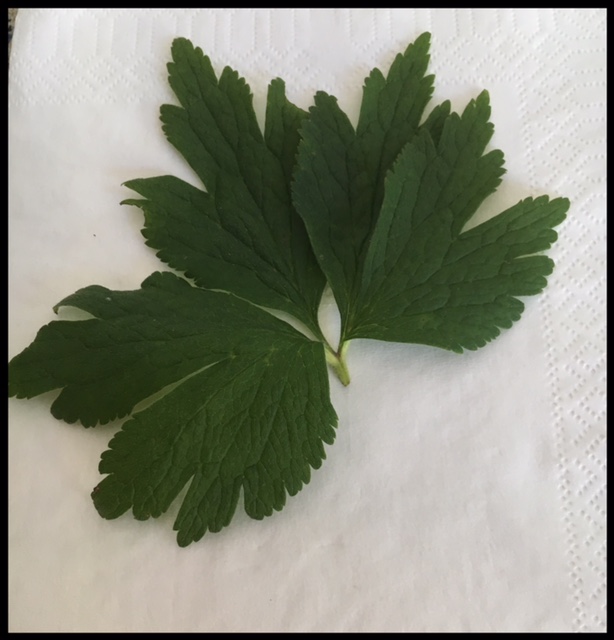
These three-lobed, deeply divided leaves feel like felt. Kids would probably enjoy touching them.
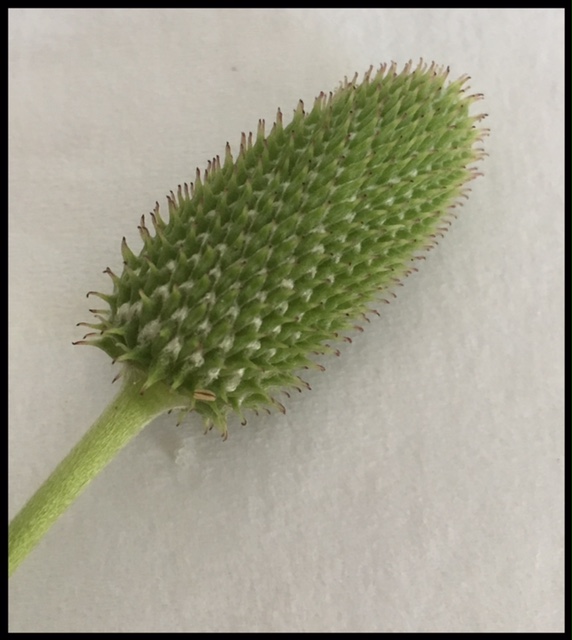
The seed head, shaped like a thimble, has an interesting texture. It elongates as it matures.
A Positive Recommendation
All in all, we would recommend thimbleweed if you are interested in building habitat in your garden. It can play an important role in a healthy ecosystem. It may not be an Emmy or Oscar winner — but it’s a solid performer, nevertheless. It comes in other varieties, also, some of which do not grow as tall as the candle anemone.
Plant a thimbleweed — and you may see more beneficial insects and fewer pests in your garden.
Look for more native plant reviews in upcoming posts.
Like this post? Sign up to receive an email each time a new post is available. We will never loan, sell or rent your email address — that’s a promise! Please use the buttons below to share with others — and please comment. It’s nice to hear your thoughts.